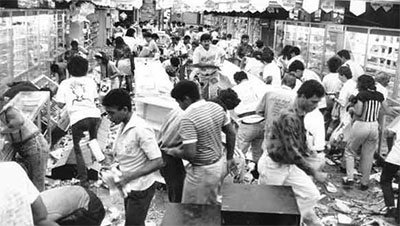 |
Peoples' movements and protests |
 |
|
MobilizationsFrench RevolutionThe Russian revolutionIMF uprisingsBack to Bread seizuresBack to movements for the commonsBack to Old movementsBack to main page |
IMF uprisings
On December 20, 2001, giant demonstrations in Buenos Aires forced the Argentine government to resign. A couple of interim governments were forced to surrender after failing to stop the demonstrations. Factories were occupied, militias were set up by unemployed roadblocks, and local administrations were set up to take over state tasks, including printing money. Only after a third government showed that it intended to treat the International Monetary Fund and foreign creditors curtly and also to expose corruption did a kind of normality return to the country. The Argentine uprising was only the most far-reaching of a series of so-called IMF uprisings that began in Peru in 1976, reached a peak in 1985 with about 20 and then leveled off with about 10 a year. What they have in common is that they are targeting government concessions against foreign creditors represented by their muscular organization IMF. The forms of action are reminiscent of eighteenth-nineteenth-century European uprisings – that is, the lower classes of cities rise against higher prices, push through the old prices through a well-targeted use of force against intermediaries and symbolic scapegoats, punish the worst criminals against the moral economy and then hand them over to common rulers to follow the judgment of the people. You can read more about this with E.P. Thompson and George Rudé. The background is that many countries in the South during the fifties and sixties followed a development model that has been called import substitution. That is, you invest in industrialization to manufacture what you would otherwise have imported, and you pay for the investment with loans that you take out in the North. For a long time this worked well. But with the recession of the seventies, the bottom went out - not least because the rich countries suddenly raised both the dollar exchange rate and interest rates. Loans taken out at an interest rate of five percent suddenly cost twenty, and dollars obtained at a rate of GBP 0,25 would suddenly be repaid at a rate of GBP 0,75. For this to be possible, banks and the IMF demanded that Southern governments abolish all social rights and raise the tariff on all public services. The IMF uprisings have had different bases and been organized in slightly different ways in different countries. The most typical has been that the uprising has been carried out by the urban lower class and erupted when the government signaled that it had fallen away from the IMF's demands by abolishing food subsidies and raising the price of public services. Venezuela's major IMF uprising in 1989 (see photos) was triggered by elevated bus fares and led to the residents of the slum districts occupying the buses and using them for barricades, after which they stormed the shops and looted them, very disciplined and with quota systems for how much each one was allowed to take. In much the same way, the IMF uprising in Argentina went to the same year. The initiators of the uprisings have usually been local neighborhood associations in the shantytowns, housewives’ associations, cooperative dining halls or churches. However, these have not ”controlled” anything; the actions have developed by themselves gradually and also ended after a few days or weeks of clashes with police and military. Larger formal organizations have not been involved; In most cases, trade unions have been too weak to play an important role, and the result of the uprising has often been that governments have softened their measures somewhat in the short term. The most deviating from this pattern have been Ecuador and Bolivia. There, smallholder movements with the Native American colouring have acted well-planned and long-term, and overthrew governments with national strikes that unions and sections of the middle class have joined. The peasant movements have used the Native American identity precisely to break away from their strictly union role and take on the role of ”representative of the nation” vis-à-vis the thin upper middle class who alone have benefited from following the IMF dictates. Ecuador and Bolivia are also record holders in IMF uprisings, both in number and depth. Mexico has also partly followed the same model – to act in the longer term. Through its Revolution of 1910-20, Mexico was the initiator of Latin American populism and for a long time one of its most successful practitioners, with a number of ”popular” organizations attached to the government to carry out its policies. The IMF uprising in 1986 inspired new independent permanent organizations, which together with the Zapatista peasantry in Chiapas managed to break the hegemony of the populist organizations in the 1990s. In several West Asian and North African countries, Islamist movements have sought to create continuity and organize commons. It went well in the beginning – but gradually the Islamist organizations have tended to be co-opted by Arab oil interests and lost their focus on justice. Instead, they are stuck in a discourse of individual virtue and morality. The IMF uprising has provided one of the mass bases for the global justice movement. The other is, of course, the peasant movement.
IMF-upproren har erbjudit en av massbaserna för den globala rättviserörelsen. Den andra är förstås bonderörelsen. Reading
|

